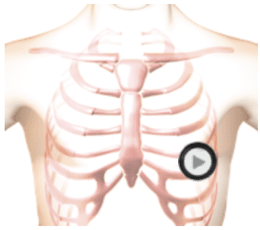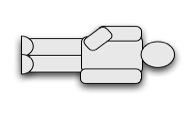Mitral Stenosis - Severe | Lessons with Audio and Video | #98
This is an example of severe mitral stenosis which is most commonly due to rheumatic heart disease. The first heart sound is decreased in intensity due to severe thickening of the mitral valve leaflets. The second heart sound is normal and unsplit Systole is silent. There is an opening snap 50 milliseconds into diastole. As mitral stenosis becomes more severe, the opening snap will occur earlier in diastole. The opening snap is followed by a low frequency murmur which occupies the remainder of diastole. The first two thirds of the murmur is diamond shaped and the remainder is a crescendo. Use the bell of the stethoscope to hear this murmur. In the animation you can see the turbulent blood flow from the left atrium into the left ventricle. You can see the severely thickened mitral valve leaflets and the markedly enlarged left atrium. The excursion of the mitral valve leaflets is severely reduced.Auscultation Sounds


Position

The patient's position should be supine left side down.
Listening Tips
S1:Decreased intensityDiastole:Opening snap then diamond shaped low-pitch murmur
Waveform (Phonocardiogram)
Observe Cardiac Animation
Review the animation and observe the turbulent blood flow from the left atrium into the left ventricle. You can see the severely thickened mitral valve leaflets and the markedly enlarged left atrium. The excursion of the mitral valve leaflets is severely reduced.
Authors and Sources
Authors and Reviewers
- EKG heart rhythm modules: Thomas O'Brien.
- EKG monitor simulation developer: Steve Collmann
-
12 Lead Course: Dr. Michael Mazzini, MD.
- Spanish language EKG: Breena R. Taira, MD, MPH
- Medical review: Dr. Jonathan Keroes, MD
-
Heart sounds and mentorship: W. Proctor Harvey, MD
- Medical review: Dr. Pedro Azevedo, MD, Cardiology
-
Last Update: 1/8/2023
Sources
-
Electrocardiography for Healthcare Professionals, 5th Edition
Kathryn Booth and Thomas O'Brien
ISBN10: 1260064778, ISBN13: 9781260064773
McGraw Hill, 2019 -
Rapid Interpretation of EKG's, Sixth Edition
Dale Dublin
Cover Publishing Company -
12 Lead EKG for Nurses: Simple Steps to Interpret Rhythms, Arrhythmias, Blocks, Hypertrophy, Infarcts, & Cardiac Drugs
Aaron Reed
Create Space Independent Publishing -
Heart Sounds and Murmurs: A Practical Guide with Audio CD-ROM 3rd Edition
Elsevier-Health Sciences Division
Barbara A. Erickson, PhD, RN, CCRN - Clinical Heart Disease
W Proctor Harvey, MD
Clinical Heart Disease
Laennec Publishing; 1st edition (January 1, 2009) -
The Virtual Cardiac Patient: A Multimedia Guide to Heart Sounds, Murmurs, EKG
Jonathan Keroes, David Lieberman
Publisher: Lippincott Williams & Wilkin)
ISBN-10: 0781784425; ISBN-13: 978-0781784429 - Project Semilla, UCLA Emergency Medicine, EKG Training Breena R. Taira, MD, MPH
Mitral Stenosis - Severe | Lessons with Audio and Video | #98